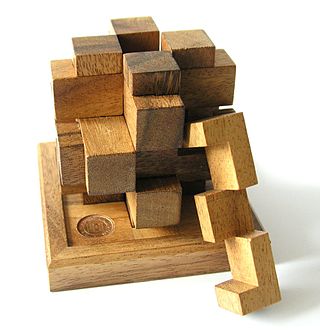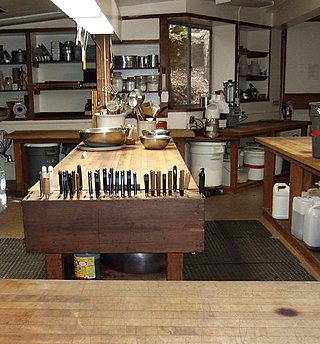
A jigsaw puzzle is a tiling puzzle that requires the assembly of often irregularly shaped interlocking and mosaicked pieces, each of which typically has a portion of a picture. When assembled, the puzzle pieces produce a complete picture.
An action figure is a poseable character model figure made most commonly of plastic, and often based upon characters from a film, comic book, military, video game or television program; fictional or historical. These figures are usually marketed toward boys and adult collectors. The term was coined by Hasbro in 1964 to market G.I. Joe to boys.

A mechanical puzzle is a puzzle presented as a set of mechanically interlinked pieces in which the solution is to manipulate the whole object or parts of it. While puzzles of this type have been in use by humanity as early as the 3rd century BC, one of the most well-known mechanical puzzles of modern day is the Rubik's Cube, invented by the Hungarian architect Ernő Rubik in 1974. The puzzles are typically designed for a single player, where the goal is for the player to discover the principle of the object, rather than accidentally coming up with the right solution through trial and error. With this in mind, they are often used as an intelligence test or in problem solving training.

Optical disc packaging is the packaging that accompanies CDs, DVDs, and other formats of optical discs. Most packaging is rigid or semi-rigid and designed to protect the media from scratches and other types of exposure damage.

Papier-mâché, frequently miswritten as paper mache, is a composite material consisting of paper pieces or pulp, sometimes reinforced with textiles, and bound with an adhesive, such as glue, starch, or wallpaper paste.

A flat or coulisse is a flat piece of theatrical scenery which is painted and positioned on stage so as to give the appearance of buildings or other background.

Frame and panel construction, also called rail and stile, is a woodworking technique often used in the making of doors, wainscoting, and other decorative features for cabinets, furniture, and homes. The basic idea is to capture a 'floating' panel within a sturdy frame, as opposed to techniques used in making a slab solid wood cabinet door or drawer front, the door is constructed of several solid wood pieces running in a vertical or horizontal direction with exposed endgrains. Usually, the panel is not glued to the frame but is left to 'float' within it so that seasonal movement of the wood comprising the panel does not distort the frame.

Kitchen cabinets are the built-in furniture installed in many kitchens for storage of food, cooking equipment, and often silverware and dishes for table service. Appliances such as refrigerators, dishwashers, and ovens are often integrated into kitchen cabinetry. There are many options for cabinets available at present.

A sliding puzzle, sliding block puzzle, or sliding tile puzzle is a combination puzzle that challenges a player to slide pieces along certain routes to establish a certain end-configuration. The pieces to be moved may consist of simple shapes, or they may be imprinted with colours, patterns, sections of a larger picture, numbers, or letters.

A butt joint is a wood joint in which the end of a piece of material is simply placed against another piece. The butt joint is the simplest joint. An unreinforced butt joint is also the weakest joint, as it provides a limited surface area for gluing and lacks any mechanical interlocking to resist external forces.

A puzzle globe is a spherical assembly of puzzle pieces that, when put together, form a complete sphere or globe. Puzzle globes will generally have a one-piece spherical substrate that supports the puzzle pieces as they are laid in place. In some puzzle globes the substrate is steel and the puzzle pieces are magnetic, the magnetic attraction keeping pieces on the lower portion of the sphere from falling off.

Perfection is a game originally produced by the Pennsylvania company Reed Toys and then by the Milton Bradley company. The object is to put all the pieces into matching holes on the board before the time limit runs out. When time runs out, the board springs up, causing many, if not all, of the pieces to fly out. In the most common version, there are 25 pieces to be placed into a 5×5 grid within 60 seconds.

Segmented turning, also known as polychromatic turning, is a form of woodturning on a lathe where the initial workpiece is composed of multiple parts glued together. The process involves gluing several pieces of wood to create patterns and visual effects in turned projects.

An egg carton is a carton designed for carrying and transporting whole eggs.

G.I. Joe: America's Movable Fighting Man is a line of action figures produced by Hasbro. The initial product offering represented four of the branches of the U.S. armed forces. The term G.I. stands, in popular usage, for Government Issue and became a generic term for U.S. soldiers, especially ground forces. The term originated in WWI, when much of the government-issued equipment was stamped "G.I.", meaning that it was made from galvanized iron. The development of G.I. Joe led to the coining of the term "action figure".
TDC Games is a board game and jigsaw puzzle manufacturer formerly located in Itasca, Illinois. The company creates and sells family games, jigsaw puzzles, board games, and adult-oriented games. The company has merged with Wood Expressions of California, www.woodexpressions.com

The Eternity II puzzle is an edge-matching puzzle launched on 28 July 2007. It was developed by Christopher Monckton and marketed and copyrighted by TOMY UK Ltd as a successor to the original Eternity puzzle. The puzzle was part of a competition in which a $2 million prize was offered for the first complete solution. The competition ended at noon on 31 December 2010, with no solution being found.

Stave Puzzles is an American jigsaw puzzle company located in Norwich, Vermont. The company was started in 1974 by Steve Richardson and Dave Tibbetts and was called Stave—a portmanteau of their first names. They manufacture hand cut jigsaw puzzles made from cherry-backed, 5-layered, 1⁄4-inch (6.4 mm) wood. Stave produces several different puzzles types ranging from traditional puzzles, teaser puzzles which can have many open areas within the puzzles, trick puzzles in which the puzzles can be put together in two or more ways of which only one is correct. They also create three-dimensional puzzles, limited edition puzzles, and complete custom puzzles. Each puzzle is provided in a green and blue box and does not include a picture of the completed puzzle. Stave Puzzles is the largest hand-cut jigsaw puzzle company in the United States and competes with laser-cutting companies like Liberty Puzzles and Artifact Puzzles.

The Wentworth Wooden Jigsaw Company is a British maker of jigsaw puzzles with whimsically shaped pieces reflecting the theme of the image portrayed on the puzzle. It was founded in 1994 by Kevin Wentworth Preston and is based in the village of Pinkney near Malmesbury, Wiltshire, an area of England known as the Cotswolds.
Cardboard is a generic term for heavy paper-based products. The construction can range from a thick paper known as paperboard to corrugated fiberboard which is made of multiple plies of material. Natural cardboards can range from grey to light brown in color, depending on the specific product; dyes, pigments, printing, and coatings are available.






















